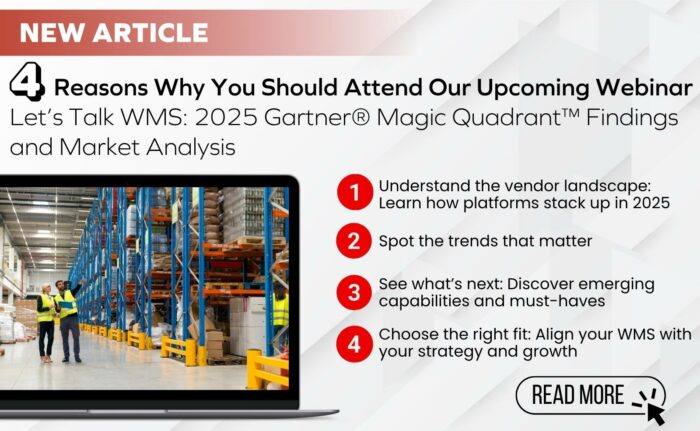
A cloud-based WMS is the backbone of modern warehouse operations, acting as the central command hub that coordinates every activity inside the facility. But a cloud WMS doesn’t live in isolation. To unlock its full potential—and keep pace with the fast-moving demands of high-growth operations—cloud WMS integrations are essential.
The best systems don’t just manage fulfillment; they connect seamlessly with the rest of your technology stack, including:
- Enterprise Resource Planning (ERP) Systems
- Multiple Sales Channels (e-commerce and digital commerce solutions)
- Order Management Systems (OMS)
- Warehouse Hardware and Automation
- Electronic Data Interchange (EDI) Systems
- Shipping Carriers
- Transportation Management Systems (TMS)
- Customer Relationship Management (CRM) Systems
- Time & Attendance (T&A) Solutions
Understanding how a cloud WMS integrates with these platforms—and the value those integrations deliver—should guide both your system selection and implementation process.
Cloud WMS Integration #1: ERP Systems
ERP platforms serve as centralized databases for finance, HR, supply chain, procurement, and more. By integrating with a cloud WMS, data flows seamlessly between departments, ensuring accuracy and eliminating silos.
Typical shared data includes:
- Inventory data: stock levels, locations, and adjustments
- Order information: purchase orders, shipping details, and status
- Financials: COGS, valuation, and reporting metrics
- Supplier/customer records
- Performance metrics: picking rates, accuracy, and utilization
Together, an ERP and cloud WMS enable accurate reporting, faster fulfillment, stronger forecasting, and streamlined procurement.
Cloud WMS Integration #2: Sales Channels
E-commerce relies on multiple digital storefronts: marketplaces (Amazon), direct websites, social platforms, and carts. Integrating these with a cloud WMS aligns your supply chain from click to delivery.
- Marketplaces: Centralized order processing and inventory across channels.
- Websites: Automatic stock updates, order tracking, and pricing accuracy.
- Social media: Sync orders from social selling while monitoring demand trends.
- Shopping carts: Real-time stock adjustments as items are added/removed.
This ensures accurate inventory, faster fulfillment, and a smoother customer experience.
Cloud WMS Integration #3: OMS
An OMS consolidates orders across channels. Paired with a cloud WMS, it ensures orders are fulfilled accurately and efficiently. Data shared includes:
- Order details
- Inventory levels
- Picking/packing instructions
- Shipping updates
- Returns information
- Workload capacity metrics
This integration eliminates disconnects between sales and fulfillment.
Cloud WMS Integration #4: Warehouse Hardware & Automation
From barcode scanners to autonomous mobile robots, automation is transforming the warehouse. A cloud WMS integrates with both hardware and robotics to manage real-time data and optimize material handling.
- Hardware: scanners, conveyors, forklifts.
- Automation: AGVs, AMRs, AS/RS, pick-to-light, robotic sortation.
As Amit Levy of Made4net notes: “The cloud WMS has become the true control tower—no longer just managing people, but orchestrating both people and machines.”
Cloud WMS Integration #5: EDI Systems
EDI digitizes and standardizes documents like POs, invoices, and ASNs. Integrated with a cloud WMS, it enables:
- Automated purchase order processing
- Real-time shipment and inventory updates
- Vendor-managed inventory (VMI)
- Compliance-ready documentation
This reduces manual effort and ensures accuracy in industries with strict regulatory standards.
Cloud WMS Integration #6: Shipping Carriers
Connecting a cloud WMS with carriers (FedEx, UPS, etc.) automates:
- Carrier selection & rate shopping
- Label creation and documentation
- Tracking and delivery notifications
- Returns handling and cost management
These integrations provide both cost savings and better customer visibility.
Cloud WMS Integration #7: Transportation Management Systems (TMS)
TMS platforms handle route planning, load optimization, and carrier management. Together with a cloud WMS, they provide:
- Real-time tracking
- Seamless order and shipment coordination
- Freight cost allocation
- Load planning and issue resolution
This streamlines the warehouse-to-delivery connection.
Cloud WMS Integration #8: Customer Relationship Management (CRM)
When integrated, CRMs link customer history with fulfillment data from the cloud WMS. This enables:
- Personalized service
- Real-time order and inventory visibility
- Backorder and return management
- Forecasting and targeted campaigns
The result is higher customer satisfaction and stronger loyalty.
Cloud WMS Integration #9: Time & Attendance Systems
Labor is one of the highest warehouse costs. Integrating T&A systems with a cloud WMS helps:
- Track labor hours and productivity
- Align staffing with demand
- Improve compliance and payroll accuracy
- Support incentive programs
This reduces costs and ensures efficient staffing.
The Bottom Line
A cloud-based WMS is not just a standalone tool—it’s the central nervous system of your fulfillment operation. Its ability to integrate with ERP, OMS, sales channels, EDI, carriers, CRM, TMS, and workforce systems makes it mission-critical for optimizing performance and staying competitive.
Forward-thinking 3PLs and retailers alike are embracing cloud WMS integrations to improve productivity, cut costs, and deliver better customer experiences. The businesses that succeed won’t just manage warehouses; they’ll orchestrate connected ecosystems.


